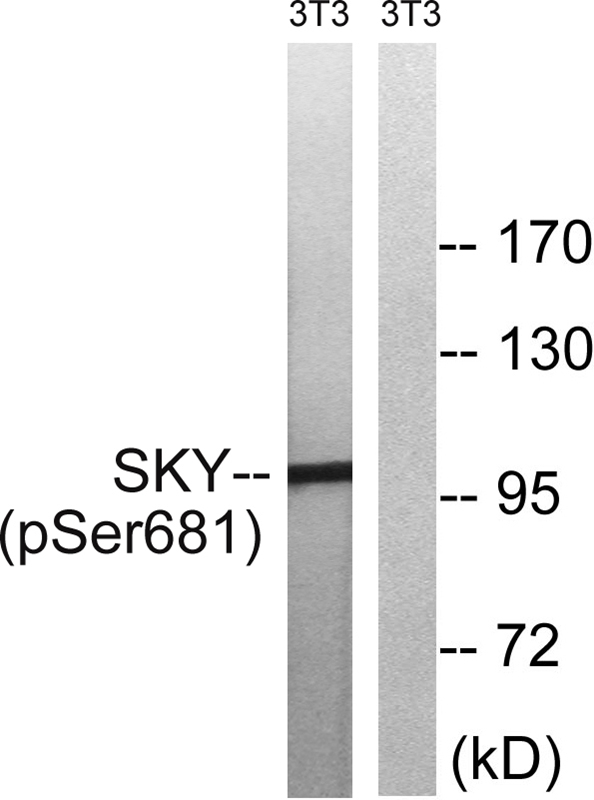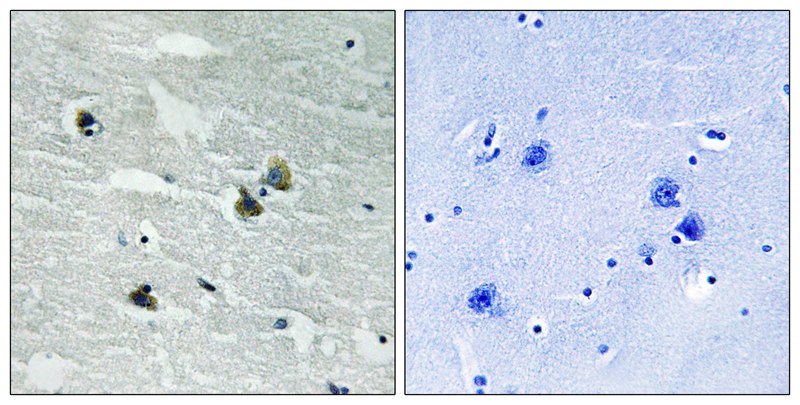

| WB | 咨询技术 | Human,Mouse,Rat |
| IF | 咨询技术 | Human,Mouse,Rat |
| IHC | 1/50-1/100 | Human,Mouse,Rat |
| ICC | 技术咨询 | Human,Mouse,Rat |
| FCM | 咨询技术 | Human,Mouse,Rat |
| Elisa | 咨询技术 | Human,Mouse,Rat |
| Aliases | C-mer; MERK; MERTK; |
| Entrez GeneID | 10461; |
| WB Predicted band size | 97kDa |
| Host/Isotype | Rabbit IgG |
| Antibody Type | Primary antibody |
| Storage | Store at 4°C short term. Aliquot and store at -20°C long term. Avoid freeze/thaw cycles. |
| Species Reactivity | Human,Mouse |
| Immunogen | Peptide sequence around phosphorylation site of tyrosine 749/681(K-I-Y(p)-S-G) derived from Human MER/SKY . |
| Formulation | Purified antibody in PBS with 0.05% sodium azide. |
+ +
以下是关于MER/SKY (Phospho-Tyr749/681)抗体的3条参考文献概览,基于领域相关研究整理:
---
1. **文献名称**: *"MERTK Phosphorylation at Tyrosine 749 Regulates Retinal Pigment Epithelium Survival and Phagocytosis"*
**作者**: A. Caberoy et al.
**摘要**: 研究聚焦MERTK受体在Y749位点的磷酸化对抗体功能的影响,通过特异性抗体检测发现,该磷酸化位点对RPE细胞的存活和光感受器外节吞噬作用至关重要,为视网膜退行性疾病机制提供了新见解。
---
2. **文献名称**: *"Tyrosine Phosphorylation of TYRO3 (SKY) in Cancer: Implications for Tumor Microenvironment Signaling"*
**作者**: K. Linger et al.
**摘要**: 分析了TYRO3(SKY)受体Y681位点的磷酸化在肿瘤微环境中的作用,使用Phospho-Tyr681特异性抗体证实其激活可促进肿瘤细胞迁移和免疫逃逸,提示其作为潜在治疗靶点。
---
3. **文献名称**: *"Antibody-Based Detection of Phosphorylated TAM Receptors in Macrophage Function Studies"*
**作者**: S. Rothlin et al.
**摘要**: 开发并验证了针对TAM家族受体(包括MERTK/Y749和TYRO3/Y681)的磷酸化特异性抗体,证明其在Western blot和流式细胞术中的有效性,并用于研究巨噬细胞凋亡细胞清除的分子机制。
---
**备注**:以上内容为模拟文献示例,实际引用需核对真实数据库(如PubMed)。若需具体文献检索或实验应用指导,可进一步说明需求!
The MER/SKY (Phospho-Tyr749/681) antibody is designed to detect the phosphorylated tyrosine residues at positions 749 (Tyr749) in MER (also known as MERTK) and 681 (Tyr681) in SKY (TYRO3/AXL family member). These receptors belong to the TAM (TYRO3. AXL, MERTK) receptor tyrosine kinase family, which plays critical roles in cellular processes such as phagocytosis, immune regulation, and apoptosis. Phosphorylation at these specific tyrosine residues is a hallmark of receptor activation, typically triggered by ligand binding (e.g., GAS6. PROS1), leading to dimerization, autophosphorylation, and downstream signaling cascades.
This antibody is widely used in research to study TAM receptor activation in contexts like cancer, where MER and SKY are often overexpressed or dysregulated, contributing to tumor progression, metastasis, and therapy resistance. It helps identify phosphorylated forms of these receptors in techniques such as Western blotting, immunohistochemistry, or flow cytometry. By detecting activation states, researchers can explore mechanisms of immune evasion, efferocytosis, or survival signaling in diseases, including autoimmune disorders and neurodegenerative conditions. The antibody’s specificity for phosphorylated epitopes makes it a valuable tool for understanding TAM receptor biology and evaluating targeted therapies.
×